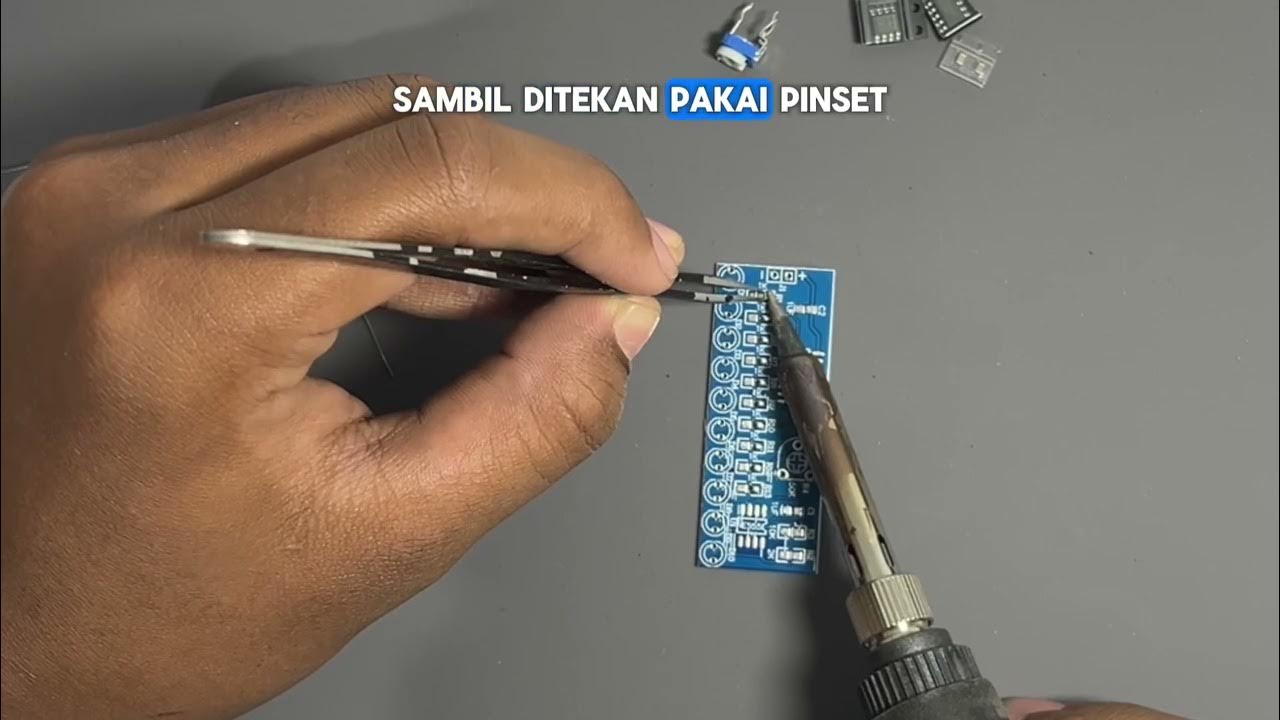Belajar Komponen SMD, Apa itu THT & SMT juga SMD?, Mengenal komponen SMD
Summary
TLDRThis video introduces Surface-Mounted Device (SMD) components and their role in modern electronics. It explains how SMD components differ from traditional through-hole components, focusing on their small size and cost-effective manufacturing process. The video covers various common SMD components, such as capacitors, resistors, inductors, diodes, LEDs, and transistors, and demonstrates how to identify them using SMD code books and datasheets. It offers practical tips for reading component codes and understanding their specifications, aiming to help viewers better work with electronic devices using SMD technology.
Takeaways
- 😀 SMD components are small, surface-mounted devices commonly used in compact electronics like mobile phones, cameras, and computers.
- 😀 The term SMD stands for Surface-Mounted Device, referring to components mounted directly on the surface of the PCB, unlike through-hole components.
- 😀 SMD components do not require holes in the PCB, reducing manufacturing costs and making the devices more compact.
- 😀 The key advantage of SMD components is their size, which allows for more efficient, space-saving designs in modern electronics.
- 😀 Common SMD components include capacitors, resistors, inductors, diodes, LEDs, and transistors, each with unique characteristics and applications.
- 😀 SMD capacitors are typically small and can be unmarked, while tantalum capacitors have polarity and must be installed correctly.
- 😀 Resistors in SMD form are identified by a code (e.g., '330' for 330 ohms) and can be marked or unmarked, depending on the size and device.
- 😀 Inductors are common in computers and other devices and typically have their values printed directly on the component.
- 😀 Diodes in SMD form are small and may have three legs or resemble ICs, requiring a codebook to identify their type.
- 😀 SMD transistors have three terminals and are identified by codes in an SMD guidebook, helping distinguish them from diodes or ICs.
- 😀 To identify SMD components, you can use an SMD codebook, which helps decode the values and specifications of components based on their printed codes.
- 😀 For resistors, the 3-digit or 4-digit code system is used (e.g., '330' = 330 ohms, '1000' = 1K ohms), while capacitors may use alphanumeric codes for value identification.
Q & A
What is SMD and why is it used in electronics?
-SMD stands for Surface-Mount Device, a type of electronic component designed to be mounted directly onto the surface of a printed circuit board (PCB). It is commonly used in small devices like mobile phones, digital cameras, and computers because it allows for compact designs and efficient manufacturing processes.
What does the acronym SMD stand for?
-SMD stands for Surface-Mount Device. It refers to components that are mounted directly onto the surface of a PCB rather than being inserted through holes.
What is the difference between SMD components and through-hole components?
-The key difference is in the mounting process. Through-hole components have long leads that go through holes in the PCB, whereas SMD components are placed directly onto the surface of the PCB, eliminating the need for holes.
What are some examples of SMD components mentioned in the video?
-The video mentions several SMD components, including capacitors (both ceramic and tantalum), resistors, inductors, diodes, LEDs, and transistors.
Why is SMD technology more cost-effective than traditional through-hole technology?
-SMD technology reduces production costs because it eliminates the need for drilling holes in the PCB and reduces the complexity of component leads. The process also supports higher component density, leading to smaller and more efficient electronic devices.
How do you read the code on an SMD component to identify its value?
-To read an SMD component’s code, you typically look it up in a reference book or database. For example, a 3-digit resistor code like '330' means 33 ohms, and a 4-digit code like '1000' represents 1000 ohms. Some components, like capacitors, use different coding schemes based on their type and polarity.
What is the difference between a ceramic capacitor and a tantalum capacitor in terms of marking?
-Ceramic capacitors are often marked with a simple code or are unmarked due to their small size, while tantalum capacitors typically have a polarity marking and are labeled for correct orientation, as reversing the polarity can damage them.
How do you identify a transistor from an SMD component with three terminals?
-To identify a transistor, look for a code in an SMD reference book. A component with three terminals may be a transistor, but it could also be an IC or diode. The specific code helps to determine its type, such as whether it's a transistor or another component.
What is the function of an inductor in an electronic device?
-An inductor stores energy in a magnetic field when electric current passes through it. It is used in electronic circuits to filter signals, manage power, and create resonance in oscillators.
How can you confirm the exact type of a component when its code is unclear?
-If the code is unclear, you can use the component's package size and configuration to help identify it. For further certainty, use a component reference guide or database to cross-reference the code with details like the component's type, manufacturer, and specifications.
Outlines

此内容仅限付费用户访问。 请升级后访问。
立即升级Mindmap

此内容仅限付费用户访问。 请升级后访问。
立即升级Keywords

此内容仅限付费用户访问。 请升级后访问。
立即升级Highlights

此内容仅限付费用户访问。 请升级后访问。
立即升级Transcripts

此内容仅限付费用户访问。 请升级后访问。
立即升级浏览更多相关视频

Circuit Skills: Surface Mount Devices

Understand resistors better than EVERYONE, a PRO guide to all common resistors.

Lec 63: Familiarity with Components - I

Cara Menyolder SMD Menggunakan Solder Biasa Tanpa Mesin

Componentes Eletrônicos | ELETRÔNICA BÁSICA PARA INICIANTES #01 | Eletrônica Board

Elektronika Dasar 004 Resistor 04 Universitas Jember
5.0 / 5 (0 votes)
